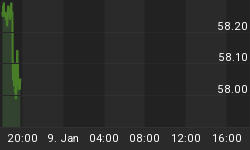Recently, we posted an update on using a 9 RSI indicator setting because it is fast and pretty good at showing positive divergences.
Another benefit of using the 9 RSI we said, was that an investor could often see the market changing direction early in the game.
But, let's face it, investors are often edgy about the direction of an indicator ... which is why having another indicator confirm the change of direction is a good idea. For a valid confirmation, one should always use an indicator or data source that is not a variant of the original.
So today, let's look at our 9 C-RSI chart by itself and then with a confirming indicator.
In today's first chart, you can see our original 9 C-RSI indicator chart, and when the C-RSI went positive or negative. Note how the NYA Index also changed its trending direction at those points. Okay, now let's add a confirming indicator in the second chart posted below ...
(By the way, if you are asking yourself what the difference is between a C-RSI and RSI indicator, here is the answer: The C-RSI is actually a RSI indicator reading minus a value of 50. We create such changes in popular indicators to make them simpler for investors to read and interpret. For instance ... when our C-RSI has a reading of 0, it is neutral ... and then anything above 0 is positive and anything below 0 is negative ... On a standard RSI indicator ... 50 is neutral and anything below 50 is negative. That can be confusing for some, because intellectually ... a +45 should be construed as a positive, when in fact, it is really negative by 5 points on the RSI indicator.)

So now, let's look at the above chart with a "confirming indicator".
One way to do this is to plot the NYSE's Declining Volume against a C-RSI of 9. Now Declining Volume, is an opposite indicator to the direction of the stock market, so we will invert it so it tracks with the direction of the stock market.
For this Inverted Declining Volume chart, we have zero-based it so that one can easily see whether or not it has a positive of negative influence in the stock market.
Now look at the chart below, and note when the signal coming from the Inverted Declining Volume indicator changes relative to when the C-RSI crosses above or below zero line.
In each case, the Inverted Declining Volume confirmed a C-RSI cross-over by showing a reading & trend change that corresponded with the C-RSI signal change.
(The NYSE inverted Declining Volume chart is posted daily on our paid subscriber sites. It is now on the Advanced site and can be found in Section 2, Chart 4.Depending on the market trend, it is moved back and forth, between the Advanced and Standard sites.)
















